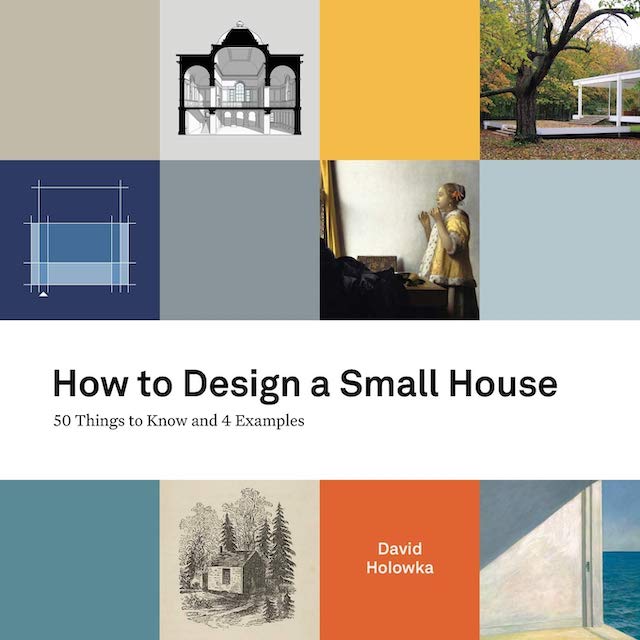How to Design a Small House
How to Design a Small House: 50 Things to Know and 4 ExamplesDavid HolowkaSmall House Lab, August 2020Paperback | 8-1/2 x 8-1/2 inches | 158 pages | 96 illustrations | English | ISBN: 978-1734422313 | $29.95BOOK DESCRIPTION:Why do the words "little house" go straight to the heart, as Sir John Summerson observed? Clearly, something beyond economy is at work. For centuries, the idea of a minimal dwelling has captivated thinkers who saw it as closer to nature, the world's and our own. Uniquely, a small house can possess human scale and presence, immerse us in nature, intensify a feeling of sanctuary, simplify life, and free up time for living. How to Design a Small House analyzes this potential and shows how to realize it in a more fulfilling home. It proposes not a tiny house, but one less than half the average size of today's new home, scaled to our time's smaller households. Drawing on literature, the visual arts, architectural history, and evolutionary psychology, its fifty short chapters weave a coherent design approach from considerations practical to subconscious. Richly illustrated, it includes vivid 3D renderings of iconic prototypes and four original house-design examples.David Holowka is an architect with over 40 years of experience. He sees home design as architecture's most fundamental concern, addressing the timeless question of how to live. This view has taken him to great houses around the world in search of their lessons. The celebrated experimental architect Lebbeus Woods called him a "serious critic." His writing on the iconic Farnsworth House is extensively quoted in Alex Beam's recent book, Broken Glass: Mies van der Rohe, Edith Farnsworth, and the Fight Over a Modernist Masterpiece.REFERRAL LINKS: dDAB COMMENTARY:Easily the most famous modern houses that can also be called small are Mies van der Rohe's Farnsworth House in Plano, Illinois, and Philip Johnson's Glass House in New Canaan, Connecticut. Completed within a few years of each other in the middle of last century, the houses are intertwined through circumstance as well as form: Johnson got the idea for his house after seeing Mies's design in the run up to a MoMA exhibition, enabling Johnson to get his modern glass box finished firs. The two houses are cited frequently in architect David Holowka's breezy but informative guide to designing a small house. The pair of houses appear first in the introduction and then repeatedly among the "50 things to know" that comprise the majority of the book, each made up of one page of text opposite an illustration. The houses also clearly influenced Holowka's design of the "4 examples" interspersed between the 50 things: modern, single-level houses between 832 and 1,120 square feet that are rectilinear and open but have a lot less glass than their famous predecessors.Another couple frequent references are Walden; or, Life in the Woods by Henry David Thoreau and the notion of the Primitive Hut, most famously depicted by Charles Eisen in the frontispiece to Marc-Antoine Laugier: Essai sur l'architecture in 1755. These pre-modern precedents are more philosophical than architectural, clearly aligned with simplicity, both in the paring down of belongings and of decoration, and in leading a simple life free of distractions. Thoreau's one-room cabin at Walden Pond and the gable form of the sticks and trees in Eisen's engraving make me think of another precedent for the design of small houses, one that does not appear to be mentioned in Holowka's book: Charles Moore's own house in Orinda, California, built one decade after the Mies and Johnson houses. Square in plan and a little over 700 square feet, the once-small house (this century it was unfortunately engulfed by an expansion that multiplied its size by five) embodies many of the considerations that Holowka clearly explains in words and images, including "One-Room Appeal," "Box Breaking," and "Clarity."I mention Moore's house because I wonder if Holowka's four small-house designs would have gone in a different direction if he was drawn to it — or Wright's Usonian houses, Le Corbusier's Cabanon, or something else — over the mid-century boxes of Mies and Johnson. Although this pair of glass boxes have been criticized on functional grounds, especially in terms of privacy and heat gain, the formal similarities between them and Holowka's designs is undeniable. The four designs in the book are highly practical, overcoming their precedents' shortcomings, but they also rely on such features as sliding pocket doors, which many homeowners would not pursue, due to expense and/or difficulty of construction. Their inclusion points to a particular bespoke brand of modern residential design, one obviously preferred by Holowka.So I'd be curious to see if someone, not even an architect necessarily, using the 50 things as a template, would come up with four dramatically different examples than the author; or if the modern minimalism of the Farnsworth House and Glass

David Holowka
Paperback | 8-1/2 x 8-1/2 inches | 158 pages | 96 illustrations | English | ISBN: 978-1734422313 | $29.95
BOOK DESCRIPTION:
REFERRAL LINKS:
SPREADS:









